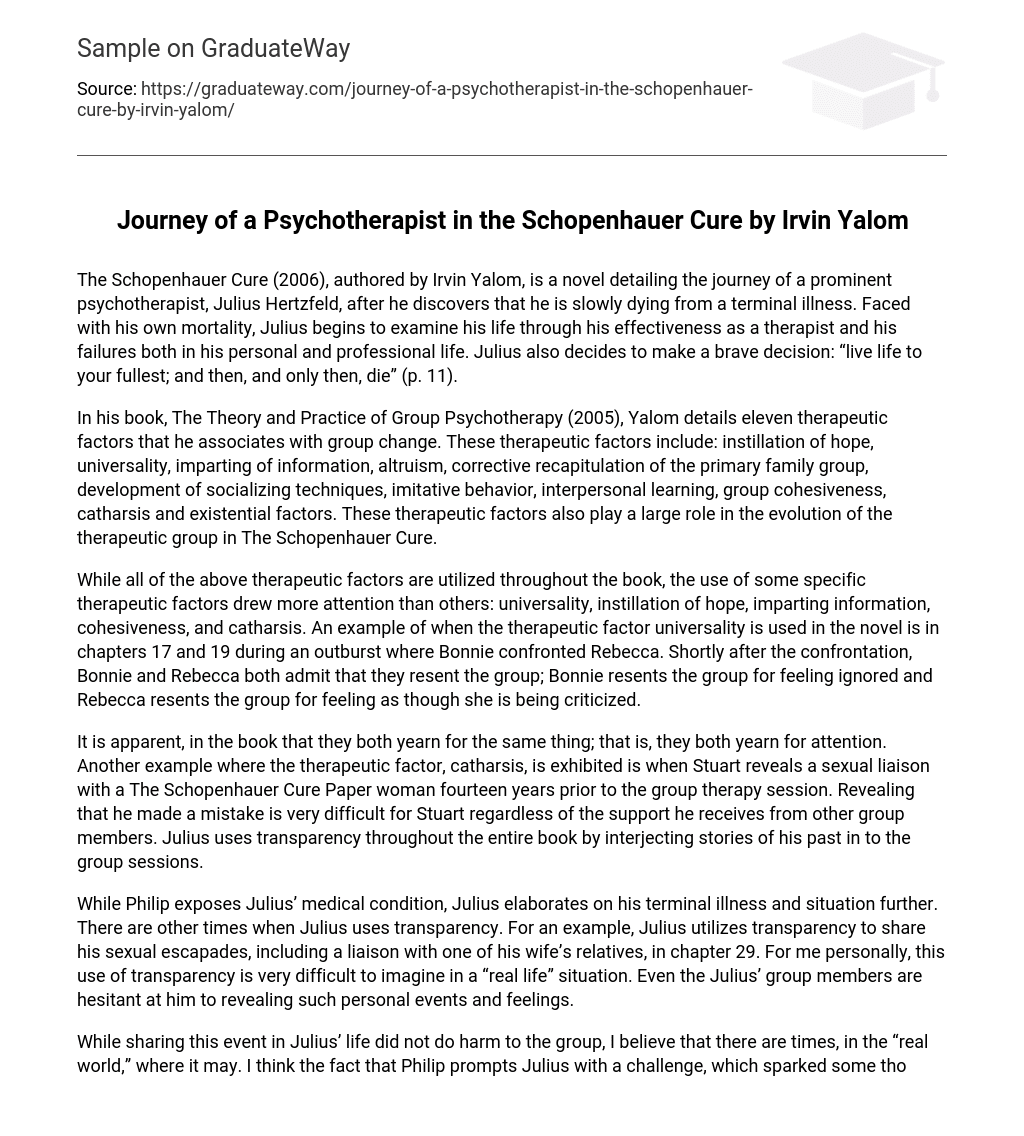The Schopenhauer Cure (2006), authored by Irvin Yalom, is a novel detailing the journey of a prominent psychotherapist, Julius Hertzfeld, after he discovers that he is slowly dying from a terminal illness. Faced with his own mortality, Julius begins to examine his life through his effectiveness as a therapist and his failures both in his personal and professional life. Julius also decides to make a brave decision: “live life to your fullest; and then, and only then, die” (p. 11).
In his book, The Theory and Practice of Group Psychotherapy (2005), Yalom details eleven therapeutic factors that he associates with group change. These therapeutic factors include: instillation of hope, universality, imparting of information, altruism, corrective recapitulation of the primary family group, development of socializing techniques, imitative behavior, interpersonal learning, group cohesiveness, catharsis and existential factors. These therapeutic factors also play a large role in the evolution of the therapeutic group in The Schopenhauer Cure.
While all of the above therapeutic factors are utilized throughout the book, the use of some specific therapeutic factors drew more attention than others: universality, instillation of hope, imparting information, cohesiveness, and catharsis. An example of when the therapeutic factor universality is used in the novel is in chapters 17 and 19 during an outburst where Bonnie confronted Rebecca. Shortly after the confrontation, Bonnie and Rebecca both admit that they resent the group; Bonnie resents the group for feeling ignored and Rebecca resents the group for feeling as though she is being criticized.
It is apparent, in the book that they both yearn for the same thing; that is, they both yearn for attention. Another example where the therapeutic factor, catharsis, is exhibited is when Stuart reveals a sexual liaison with a The Schopenhauer Cure Paper woman fourteen years prior to the group therapy session. Revealing that he made a mistake is very difficult for Stuart regardless of the support he receives from other group members. Julius uses transparency throughout the entire book by interjecting stories of his past in to the group sessions.
While Philip exposes Julius’ medical condition, Julius elaborates on his terminal illness and situation further. There are other times when Julius uses transparency. For an example, Julius utilizes transparency to share his sexual escapades, including a liaison with one of his wife’s relatives, in chapter 29. For me personally, this use of transparency is very difficult to imagine in a “real life” situation. Even the Julius’ group members are hesitant at him to revealing such personal events and feelings.
While sharing this event in Julius’ life did not do harm to the group, I believe that there are times, in the “real world,” where it may. I think the fact that Philip prompts Julius with a challenge, which sparked some thoughts within Julius about the “lack of reciprocity in the authentic therapy relationship,” (p. 240) inspired Julius to use transparency with a depth that he had not before. As far as dealing with transference within the group, it seems that there are times when Julius allows the other group members to confront it and there are times where he takes responsibility to bring it to the group members’ attention.
I think it takes a skilled and experienced group therapist who truly knows his group members to determine which method is most appropriate and helpful. For an example, when Bonnie is transferring her feelings about her childhood on to Rebecca, Julius prompts the group members to address it – specifically Stuart and Gill. The Schopenhauer Cure Paper While reading the book, I was thoroughly impressed by the group’s cohesion. Sometimes, a group member says something that would temporarily threaten the group’s cohesion, but ultimately, it seems as though those instances help form a stronger bond within the group.
Two specific instances that threatened the group’s cohesion revolved around Philip. When Philip is first introduced in to the group, the group has a difficult time understanding his behavior, his thoughts, his communication patterns and his seemingly obsession with Schopenhauer. Some of the group members feel that they should protect Philip and others feel that they should confront and expose Philip. These two different approaches by individuals in the group temporarily threaten the group’s cohesion as the group divides according to their approach to how to deal with Philip.
The second instance is when Pam returns from her trip to India and finds that Philip is now part of the group. Pam’s previous experience with Philip is very difficult for her to deal with and definitely impacts the group’s cohesion. The Schopenhauer Cure was an interesting read. As both a former patient in therapy and a social worker, I found the book a valuable asset to those in group therapy or those leading groups. As a group member, I could really relate to Bonnie and her feelings, experiences and fears.
As a social worker who will one day be leading group therapy sessions, this book is helpful as it provides almost visible, and certainly concrete, examples of certain therapeutic techniques of group therapy. I enjoyed this book immensely and as a result of this pleasurable experience, I plan to do further research on Yalom and his other written works. The Schopenhauer Cure Paper References Yalom, I. (2005). The theory and practice of group psychotherapy. (5th ed. ) Cambridge, MA: Basic Books. Yalom, I. (2006). The Schopenhauer cure. New York: Harper Perennial.





